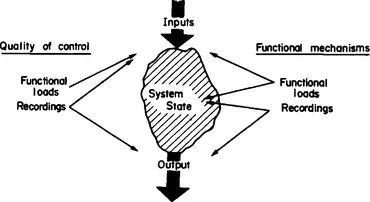![]()
CHAPTER 1
Methods of Investigation of the Intracranial Circulation
Publisher Summary
This chapter discusses the methods of investigation of the regional or total cerebral blood flow from the point of view of systems analysis. The systems analysis approach means treating the object of investigation as a complex system. This approach involves the examination of the system as a whole while simultaneously giving due consideration to the interaction of all its functionally significant components. The systems analysis involves special principles and methods, one of which is mathematical modelling that has wide applications. It can be the most appropriate method where the activities of a particular functional unit are well-enough understood to predict their direction and to assess its functional state at any given time. The systems approach is based on a clear delineation of the functional system under investigation and the identification of the channels by which it communicates with other systems. The channels through which it receives external influences are its input; the results of its activities are its output.
INVESTIGATIONS of the blood supply to the brain and its underlying biophysical processes must adhere to the same principles which apply to investigations of functional systems in general, i.e., the information obtained must throw light on the functional processes as well as the “quality” of the functioning of the system. The above proposition follows from a systems analysis approach, i.e., from treating the object of investigation as a complex system. By contrast with traditional physiological methods of examining separate factors within a functional unit, the systems analysis approach involves the examination of the system as a whole while simultaneously giving due consideration to the interaction of all its functionally significant components. Systems analysis involves special principles and methods, one of which is mathematical modeling which has very wide applications. Systems analysis can be the most appropriate method where the activities of a particular functional unit are well enough understood to predict their direction and to assess its functional state at any given time. The systems approach is based on a clear delineation of the functional system under investigation and the identification of the channels by which it communicates with other systems. The channels through which it receives external influences are its input, the results of its activities are its output. (Fig. 1)
FIG. 1 General principles of physiological investigations from a systems point of view.
In studies of functional systems by the method of systems analysis, three groups of variables must be recorded simultaneously. These are: (1) variables which characterize the changes caused in the system by way of channels connecting it with other systems or its input; (2) variables which characterize the results of its activities or its output; (3) variables which characterize the means by which the system solves its functional tasks or the changes in its state.
It is evident that an understanding of the first two groups of variables makes it possible to assess the “quality” of the functioning of the system in question. The third group makes it possible to understand the mechanisms by which the functional task is accomplished.
This general approach to investigations of complex systems is useful in studying complex physiological systems, such as the intracranial circulation, and should be accepted as one of the valid biophysical approaches to this problem. Consequently, use is made by us of conclusions drawn from a systems approach when appraising the methods of investigation of the cerebral circulation in this chapter.
In regard to the intracranial circulation as a functional unit, both flow of blood into the cranium and out of it must be regarded as input, since the cerebral blood flow is determined by both arterial pressure and venous drainage. In examining the functioning of separate regions of the brain whose activity fluctuates constantly, the input is the functional activity of the region under investigation. The output both at the level of the whole brain and of its separate regions is the level of blood flow.
Under normal physiological conditions and in the absence of external stimuli, the input and output of a system are obviously in a state of balance. In order to assess the “quality” of its functioning, the state of the system under investigation must be changed by altering the input and observing the output. This can be achieved by a variety of functional interventions. The success of the investigation largely depends on selection of appropriate intervention. The use of functional tests is also essential for the study of the mechanisms underlying the functioning of the system under investigation, but in that case they serve the purpose of elucidating the role of individual factors which contribute to the total functioning of the system. It is important for functional tests to be quantifiable and to have a well-defined effect on the input or the state of the system.
One way of representing the organization of investigation of the intracranial circulatory system is by means of a scheme as illustrated in Fig. 2. Such a scheme envisages automated processing of results and the plan of the experiments as well as the variables and experimental intervention mentioned above. It is evident that the measurements which must be recorded to study the functioning of the regional cerebral circulation are different from those required in studies of the total cerebral circulation. In the case of the former, the input is the functional state of a particular part of the brain, in the latter it is the flow of blood into and out of the brain, i.e., the level of the systemic arterial and venous pressures. The variables which describe the state of the regional or total cerebral circulation are more alike. For example, in both cases changes in blood volume are a good indication of the tone of blood vessels and their hydraulic resistance (Moskalenko, et al., 1976a). Additional information on the state of the total cerebral circulation can be gained by measuring the intracranial pressures (ICP). The state of regional blood flow is reflected in the tensions of oxygen (PO2) and carbon dioxide (PCO2) in brain tissue. The output of the regional as well as of the total blood supply to the brain can be determined by recording the intensity of blood flow in part or the whole of the brain.
FIG. 2 Scheme of investigation of the cerebral circulatory system. LCBF, local cerebral blood flow; Ap, arterial pressure; Vp venous pressure; EPG, electroplethysmography; ICP, intracranial pressure; TCBF, temperature recording of the blood flow.
Experimental interventions which help to demonstrate the special features of the functioning of the cerebral circulation are indispensable. Such procedures can affect the flow of blood into and out of the brain, intracranial pressure, acid-base balance of the CSF, etc., i.e., they affect the input into the system and its state depending on the objectives of the investigation. Naturally occurring processes, such as periodic fluctuations of the arterial and venous pressure, related to cardiac and respiratory activity, also belong to the factors which can be studied profitably. As shown in Fig. 2, it is possible to vary the functional interventions according to the state of the system under investigation. This can also be achieved by using a computer in the experimental design. It is also very useful in analyzing experimental results.
The effectiveness of investigations of the cerebral circulation is determined not only by the sophistication of methods, but also by the selection of optimal experimental procedures, such as selection of appropriate stimuli. Experiments based on such principles make it possible to elucidate the biophysical characteristics of the regulatory system of both the regional and general cerebral circulation from the changes observed in the input and output of the system in response to certain experimental interventions. The selection of appropriate parameters makes it possible to understand the mechanisms underlying the observed phenomena.
Methods of Recording V...


